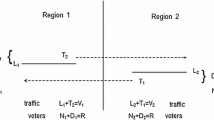Abstract
This paper offers a new political economy explanation for thepervasive problem of siting hazardous waste treatment facilitiesin federal system. We first show that a decentralized systemyields the first-best waste treatment capacity level and that acentralized structure gives rise to free-riding behavior amonglocal jurisdictions. In our model, each community seeks toinfluence the central government through political contributions.This leads to suboptimal levels of treatment capacity. Thecapacity is increasing in the compensation level if the marginalbenefit of treatment capacity is sufficiently large, and in thegovernment's weight on aggregate social welfare relative tolobbying activities. The centralized system can replicate thedecentralized system with a sufficiently high compensation level.Since compensation has proved difficult, a centralized systemfaces greater obstacles than a decentralized system.
Similar content being viewed by others
References
Aidt, T. S. (1998), ‘Political Internalization of Economic Externalities and Environmental Policy’, Journal of Public Economic 69(1), 1-16.
Bernheim, B. D. and M. D. Whinston (1986), ‘Menu Auctions, Resource Allocation, and Economic Influence’, Quarterly Journal of Economics 101, 1-31.
Dixit, A., G. M. Grossman and E. Helpman (1997), ‘Common Agency and Coordination: General Theory and Application to Government Policy Making’, Journal of Political Economy 105, 752-769.
Fredriksson, P. G. (1997), ‘The Political Economy of Pollution Taxes in a Small Open Economy’, Journal of Environmental Economics and Management 33(1), 44-58.
Fredriksson, P. G. (1999), ‘The Political Economy of Trade Liberalization and Environment Policy’, Southern Economic Journal 65(3), 513-525.
Frey, B. S., F. Oberholzer-Gee and R. Eichenberger (1996), ‘The Old Lady Visits Your Backyard: A Tale of Morals and Markets’, Journal of Political Economy 104(6), 1297-1313.
Gerrard, M. B. (1994), Whose Backyard, Whose Risk: Fear and Fairness in Toxic and Nuclear Waste Siting. Cambridge, MA: MIT Press.
Grossman, G. M. and E. Helpman (1994), ‘Protection for Sale’, American Economic Review 84(4), 833-850.
Grossman, G. M. and E. Helpman (1995a), ‘Trade Wars and Trade Talk’, Journal of Political Economy 103, 675-708.
Grossman, G. M. and E. Helpman (1995b), ‘The Politics of Free Trade Agreements’, American Economic Review 85, 667-690.
Grossman, G. M. and E. Helpman (1996), ‘Electoral Competition and Special Interest Politics’, Review of Economic Studies 63, 265-285.
Ingberman, D. E. (1995), ‘Siting Noxious Facilities: Are Markets Efficient?’, Journal of Environmental Economics and Management 29, S20-S33.
Kleindorfer, P. R. and H. Kunreuther (1994), ‘Siting of Hazardous Facilities’, in S. M. Pollock et al., eds., Handbooks in OR & MS, Ch. 11, Vol. 6.
Kunreuther, H., J. Linneroth-Bayer and K. Fitzgerald (1994), Siting Hazardous Facilities: Lessons from Europe and America. The Wharton Risk Management and Decision Processes Center, Working Paper #94-08-22.
Kunreuther, H. and P. R. Kleindorder (1986), ‘A Sealed-Bid Auction Mechanism for Siting Noxious Facilities’, American Economic Review Papers and Proceedings 76, 295-299.
Kunreuther, H., P. R. Kleindorfer, P. Knez and R. Yaksick (1987), ‘A Compensation Mechanism for Siting Noxious Facilities: Theory and Experimental Design’, Journal of Environmental Economics and Management 14, 371-383.
Mitchell, R. and R. Carson (1986), ‘Property Rights, Protest, and the Siting of Hazardous Waste Facilities’, American Economic Review Papers and Proceedings 76, 285-290.
O'Hare, M., L. Bacow and D. Sanderson (1983), Facility Siting and Public Opposition. New York: Van Nostrand Reinhold.
O'Sullivan, A. (1993), ‘Voluntary Auctions for Noxious Facilities: Incentives to Participate and the Efficiency of Siting Decisions’, Journal of Environmental Economics and Management 25(1), S12-S26.
Persson, T. and G. Tabellini (1994), ‘A European State: Lessons from Existing Federations. Does Centralization Increase the Size of Government?’, European Economic Review 38, 765-773.
Rabe, B. G. (1994), Beyond NIMBY: Hazardous Waste Siting in Canada and the United States. Washington, DC: Brookings Institution.
Sigman, H. (1996), ‘Effects of Hazardous Waste Taxes on Waste Generation and Disposal’, Journal of Environmental Economics and Management 30(2), 199-217.
Author information
Authors and Affiliations
Rights and permissions
About this article
Cite this article
Fredriksson, P.G. The Siting of Hazardous Waste Facilities in Federal Systems: The Political Economy of NIMBY. Environmental and Resource Economics 15, 75–87 (2000). https://doi.org/10.1023/A:1008313612369
Issue Date:
DOI: https://doi.org/10.1023/A:1008313612369




